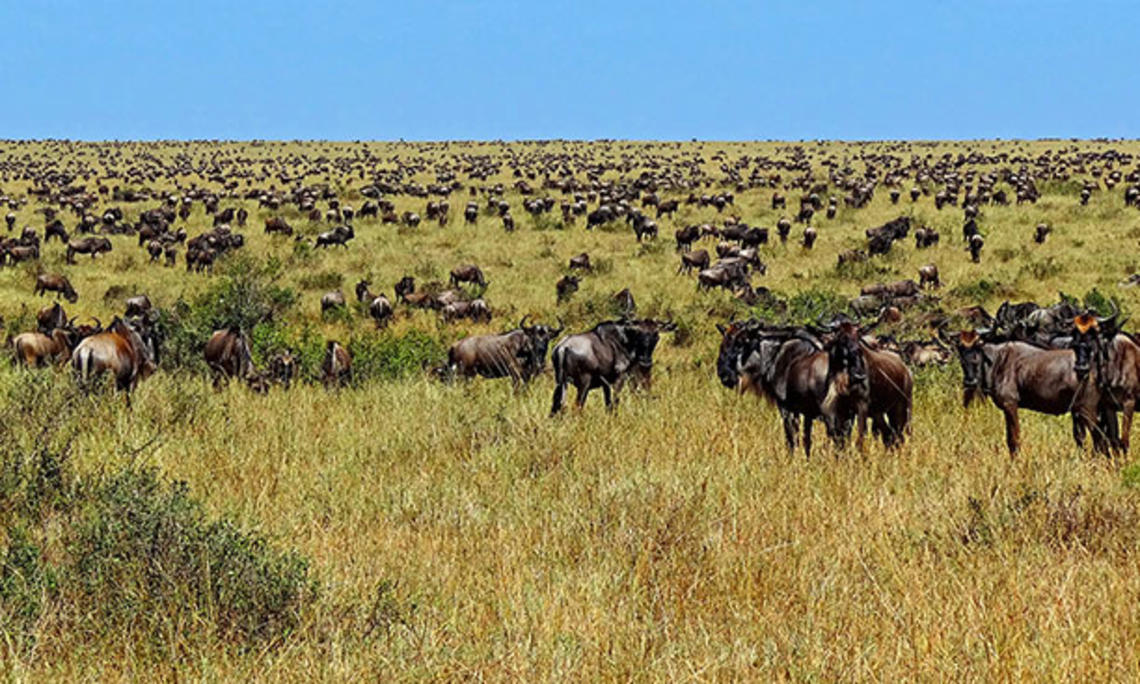
Serengeti doesn’t burn like it used to. The wildebeest have made sure of that! Their one-and-a-half million pairs of teeth do a fantastic job of reducing the grass, so there’s no fuel left for a prolonged burn. It wasn’t like this 30 years ago when I first started working there. Each evening the haunting wail of bag-pipes would echo around the small cluster of research huts, summoning a group of us to head out to help start experimental fires with the Scots researcher trying to quantify the relationship between grass height and fire temperature. He couldn’t do this work now; suppression of fires by wildebeest grazing has allowed the woodlands to expand in the middle of the park. The wildebeest increased in abundance after a deadly virus, rinderpest, was eradicated. Before this, disease outbreaks in domesticated cattle would transmit to wild wildebeest and buffalo. But after cattle were vaccinated, and the disease was eradicated in the early 1970s, wildebeest and buffalo populations increased nine-fold. The wildebeest help create more woodland, which has created better hunting grounds for lions, so that species is enjoying newfound abundance — both from an increase in wildebeest to eat and greater ease of hunting.
The interconnections among the different species in the Serengeti provide a wonderful example of one of the central research problems in ecology: How are natural food webs assembled? And how do perturbations to one species, through disease, predation, or fire, lead to changes in the abundance in other species in the web?
Understanding the mathematics and biology of this problem is arguably one of the key scientific problems of the 20th century.
READ MORE Paying Attention to Our Planet’s Parasites
Behind the Research: Andy Dobson, ecology and evolutionary biology
It is a dilemma for which we need solutions that provide general insights into the structure of all the food webs that make up the natural world in which we live and on which human life depends. It is a complex problem that involves different species, connected as a network, each node of which is a species that has different birth and death rates, social behavior (which modifies these rates), and their rates of interactions with other species. It is also a mathematical problem whose intellectual roots are firmly embedded in Princeton’s Department of Ecology and Evolutionary Biology.
Robert May, who joined Princeton’s biology department in 1973, identified the central problem in his monograph Stability and Complexity in Model Ecosystems. This work overturned the conventional wisdom that complex tropical ecosystems should be stable, since many species interacting with one another could only persist if their interactions were stabilizing. May used a very general mathematical model to show the opposite: “Increasing the number of species in an ecological food web should always reduce the probability of the system persisting”— a mathematical result that seemed to contradict the huge diversity of species coexisting in tropical environments. This set a major challenge to ecologists to determine: “What were the diverse strategies that species use to generate stable food-web structures?” The answer to this question set a vital agenda for ecology over the next 40 years, not least because the natural world was steadily eroding from human conversion of natural habitats into agricultural land and through overexploitation of marketable species and the introduction of invasive species.
The last few years have seen huge progress in our understanding of this problem. Work by Stefano Allesina and Mercedes Pascual (a former Princeton postdoc) has shown that food webs will be more stable if interactions between species are dominated by predator-prey rather than competitive interactions. This result is initially disquieting to pure Darwinists who think that competition is the main driving force in nature; less so when you realize that most competition is manifest through consumption of shared resources, which is, of course, a predator-prey or consumer-resource relationship. More recent work by Jonathan Levine (who has just joined the Princeton faculty) has shown that indirect interactions between species have powerful stabilizing effects (species A has no direct on species C, but both interact with species B).
These relationships abound in tropical forests, such as those studied each spring in Panama by Princeton juniors during their tropical semester at the Smithsonian research facilities. Each year they are amazed to discover that many tropical bird and mammal species are dependent upon figs as a continuous source of nutrients, particularly calcium. There must be at least one fig tree in fruit during any week of the year, as they are pollinated by short-lived fig wasps that must find fresh figs whenever they emerge from a recently pollinated fruit. These wasps are in turn parasitized by nematodes and other parasitic wasps that are a sister species to the pollinating fig wasps. This means that each fig contains a food web of interacting species whose offspring have to disperse and find another fig before the one their parents colonized is consumed by the birds, bats, and monkeys who rely on figs as a vital source of year-round nutrition. All of this fig complexity is dominated by consumer resource relationships: Nematodes eat fig wasps, parasitic wasp larvae feed on fig wasps, so the food-web network within each fig is likely to be transiently stable. The centuries-long lives of the adult fig trees provide an additional basal form of long-term stability, as well as a constant supply of vital nutrients, to the whole system.
It’s great to watch the faces of the students in Panama as these mysteries slowly reveal themselves to them; first the initial glimpses through the lab’s microscopes of this hidden world of parasites and pollinators within each fig, fig wasp, and the many snails we dissect from the Panama canal. And then the deeper realization that we have to use mathematics as a larger scale “macroscope” to understand how the different components of natural ecosystems such as tropical forests and savannas interact to determine the mathematical structure of these ecosystems.
These problems are much more complicated than understanding the structure and evolution of the universe. Moreover, our lives are much more dependent on understanding the mathematical structure of natural ecosystems. It’s a set of problems that we urgently need to solve in order to develop the deeper understanding that might allow us to restore and conserve the many natural ecosystems that are currently unraveling. Training Princeton students in Panama to develop a qualitative and quantitative understanding of tropical ecology has been the most exciting form of teaching I’ve ever undertaken. It’s always a deeply intensive three weeks, but many students remark they learn twice as much on these courses as they do when studying on campus. The Panama and Kenya programs are slowly creating a vital cohort of young scientists who are truly working at the cutting edge of the most important scientific problem of the 21st century.











0 Responses